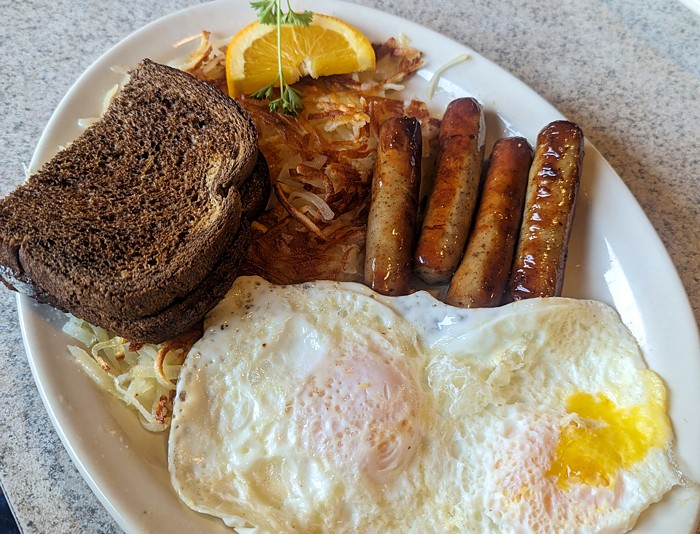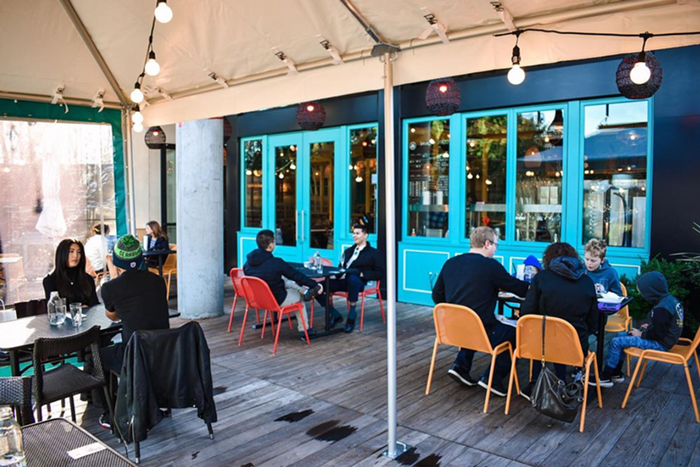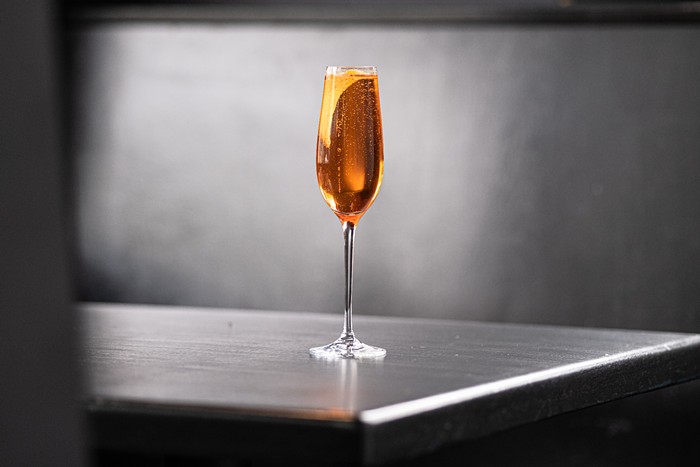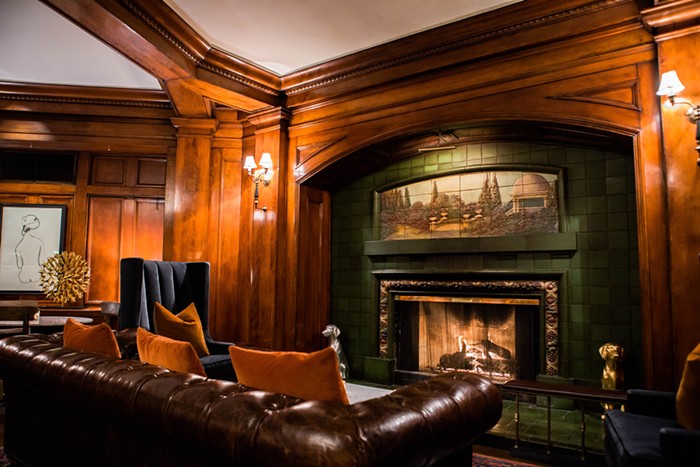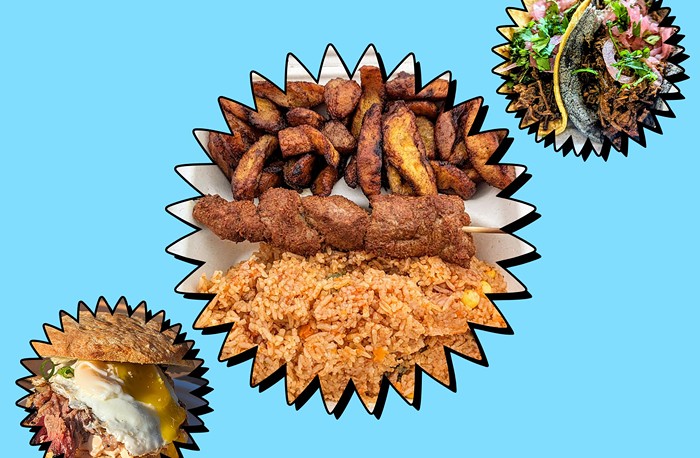The kitchen at the Book Bindery is beautiful. No, handsome is a better word—this kitchen inspires a calm, thorough-going confidence, feels safe and shipshape and solid. It's an open kitchen, but you only see it on your way to the restrooms, when it appears on your right like a luxurious European dream: a big gray marble table (the same marble as the bar top), glowing orb lights (same as in the dining area, turned up brighter), silent spick-and-span people doing meticulous things. On a pristine white sideboard and shelf are a lineup of small pumpkins and orderly rows of spotless jars of supplies. No one's going to yell in here, and nothing bad will be allowed to happen. A certain kind of person will want to just stand there and watch.
If the kitchen at the Book Bindery looks familiar, maybe you've been lucky enough to visit the kitchen at Per Se in New York; if you haven't, you can find photographs online. There it is: snowy aprons, concentration, assurance. The chef at the Book Bindery, Shaun McCrain, spent four years at Per Se, among other résumé impressivenesses. Here, the front of the house is handsome, luxurious, and confidence-inspiring, too. It's the work of Patric Gabre-Kidan—Ethan Stowell's business partner in Tavolàta, How to Cook a Wolf, and Anchovies & Olives. He knows what to do.
The Book Bindery is in a former bookbindery, next to its sibling winery Almquist Family Vintners, hidden just west of Ponti overlooking the Fremont ship canal. The out-of-the-way location—marked by a hand-lettered dead-end sign with a skull and crossbones—combined with the low ceilings, paneled cream wainscoting, blue-gray walls, and perfect lighting make it feel like both a secret and a tradition, members only. After only six weeks, it's already always full, with pairs and foursomes waiting in the entryway; if someone drops a full glass of champagne, the flute gets caught in midair, no one gets splashed, and no one seems to notice.
A couple doors have their old warehouse designations still painted on: "SHIPPING & RECEIVING," "CUSTOM FROZEN FOODS." A wall of windows looks into a room of underlit wine barrels, signaling bounty. In the middle of the barely midsized dining area, space is extravagantly wasted for a low wait station and open floor. (An all-glass greenhouse that will seat around 30 more diners is planned for early next year.) The view of the waterway is likewise relegated to a couple large but offset windows—it's clear that the view of the interior is to be privileged, too. More extravagance: the L-shaped banquette's upholstery, dark but elaborately rolled and tufted like a chesterfield, surely costing one grazillion dollars. On a stretch of blank wall, instead of art, several mirrors are canted slightly forward to reflect the room—a benevolence for the dates of the world who always gallantly take the worse seat.
It's a particular credit that the shelves full of books and curios don't look like a stage set. The volumes include the Encyclopaedia Britannica, Funk & Wagnalls, Osler's Modern Medicine, and Practical Infant Feeding; there's an hourglass, a magnification apparatus, a piece of coral, a pair of brass pheasants. Some of it came from Gabre-Kidan's house. It's almost a visual joke—ginned-up library atmospherics—but, like the tableau of the kitchen (which is also surely part false, masking tensions and crises), it looks just right, exactingly soothing.
As for the food, it is (surprise!) rich and luxurious and assured, handsomely presented, skillfully served. From the beginning, it feels right—maybe an amuse-bouche of a slim, clear-glass shot of sugar-pie-pumpkin soup with black-cardamom foam, like a savory, hot encapsulation of all that's good about pumpkin pie with whipped cream. It's gone before you could ever get tired of it, and so warming that you might take your sweater off for the first time all day. Then, with the bread, the server murmurs that the butter is sprinkled with black-lava sea salt from Hawaii. "I should hope so!" you might think, getting into the spirit of things.
Starters include opulent-sounding salads—compressed cucumber with young eggplant, autumn apple with pork belly, local greens with Banyuls (that's a French aperitif) vinaigrette. Two seafood options function flawlessly as delicacies—small in portion, lovely to look at, exquisite in flavor. Hamachi crudo is arranged like art: sweet raw curls of yellowtail, pressed slabs of marbled avocado, shavings of radish, rounds of pickled onion, house-made chili rice crisps, a few mint leaves, and intense dashi gelée, like fresh, salty cubes of the sea. The changing flavors and textures are outstanding. A barely seared, thin-sliced scallop dish, served cool, has a rush of black-truffle flavor that gives way to the scallop's sweetness; a celery-root rémoulade provides crunch and cream. If you don't mop this plate clean, you're insane.
An appetizer of sweetbreads is, of course, great—they're the chicken nuggets of the wealthy, lavish in the mouth, here with tiny bits of caramelized cauliflower, golden raisins, brown butter emulsion, and capers and a hint of citrus for kick. Clams with white beans and chorizo are merely a faultless version of the classic peasant surf and turf; there's slightly spicy-hot broth, oblong slices of toasted baguette, big basil leaves. At the Book Bindery, this is a strange, unrarified thing; to be snobby, it seems like it's in the wrong restaurant.
If you had to find fault with the mains, it'd be, as you might expect, the crime of richness. Note: The prices aren't exorbitant for the excellent ingredients and obvious expertise; starters are $10 to $18, entrées $18 to $34, and the unboring wine list has plenty of less-than-nosebleed-level options. And while some starters have a lot of white space on the plate, entrées are generous. Handmade cavatelli is currently served with—hello!—a foie gras emulsion, eye-crossingly lush and fatty. It also has so many mushrooms—matsutake, chanterelle, and brown and white alba on one night—that you might almost wish for more pasta (except: mushrooms!). And maybe you might want fewer pearl onions—this dish has enough slipperiness as it is—and a little more sylvetta (a wild arugula) for pepperiness. But this is nit-picking: It's absurdly delicious. Also absurdly good: the Mishima Ranch "flavor curve," a cut of beef that comes from around the rib eye, with a special accompanying layer of fat. This is velvety like a filet, but has more flavor; the Book Bindery cooks it with an assertive char, leaving the interior a medium-rare red velvet. It comes with—yes—a deep bordelaise sauce and—yes—bone-marrow bread pudding. The latter's more subtle than you might think, the former, not at all so. This is the best plate of beef in the city right now, but you're going to want to lie down afterward.
The pan-roasted duck verges on too rare, but doesn't quite go there; it's slightly gamey, the antithesis of greasy, like a duck steak. You might eat it compulsively for a while before you notice the softened young fennel hearts, which have been transformed into meltiness without falling apart—a rich, rich vegetable if ever there was one. Caramelized figs and the barest amount of sweet onion puree sweeten the deal. By contrast, the only entrée that didn't seem borderline overwhelming is the grilled sturgeon. Rather than meaty, the inch-thick fillet is about as light as fish can be—almost airy for something that comes from the water, with a delicate, nearly sweet flavor, fresh- tasting, barely grilled, completely lovely. It comes with black-pepper gnocchi (which aren't heavy either), chanterelles, nutty cubes of red kuri squash, a shockingly awesome squash puree, and one crisp-fried sage leaf.
If you share an appetizer, you might have room for a dessert like whiskey-laden chocolate pot de crème, or fancied-up beignets, or an amazing-looking cheese plate. And if the winery next door is open late, a tour and tasting is pretty much required. Last week was the crush, meaning rows and rows of vats of grapes with circling drunken fruit flies. The bottling line is a shiny, improbable-looking Rube Goldberg masterpiece (apparently a half-dozen humans have to oversee it in action; "It's Italian" is the explanation). If crazy-haired vintner Mike Almquist is around, he'll show you the copper stills he's using for hard-liquor experiments, and he'll tell you repeatedly how the grapes tell him what to do. After sampling a half-dozen of his reds, you'll be hearing them too. ![]()
This article has been updated since its original publication due to the unfortunate fact that Bethany Jean Clement does not know her left from her right.

